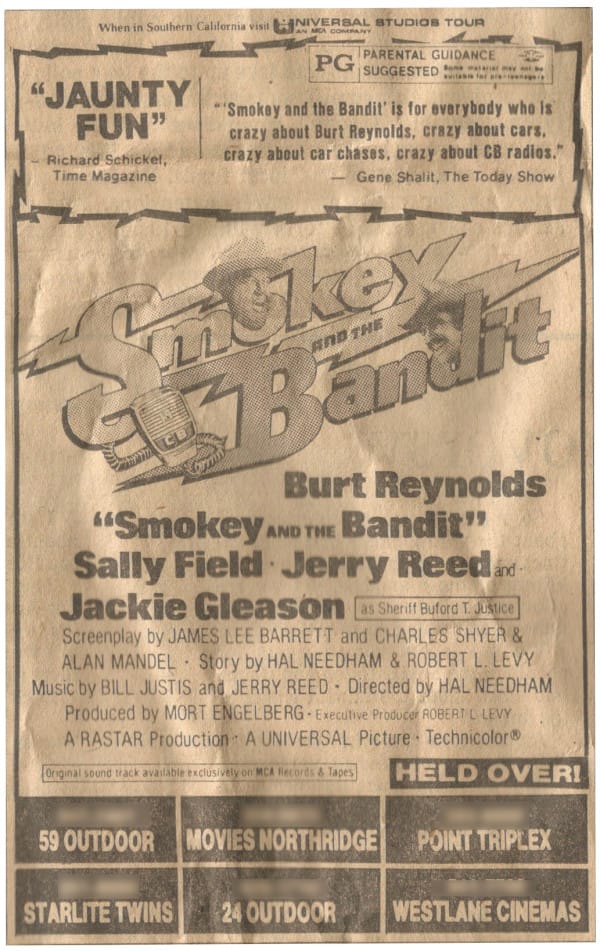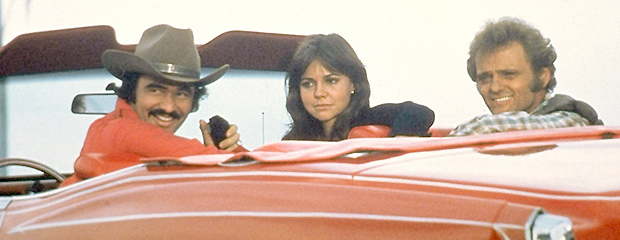Throughout the early 70s, largely forgotten movies like The Magic Garden of Stanley Sweetheart, Pufnstuf, Big Jake, Z.P.G., The Other, and Cornbread, Earl and Me filled the cinemas over Memorial Day. There were only a couple of real notable hits – Daisy Miller and Beneath the Planet of the Apes. By the end of the decade and into the 80s, however, Memorial Day had become the premiere launching pad for classics like Alien, The Shining, Return of the Jedi, and various Rocky, Indiana Jones, Rambo, Beverly Hills Cop, and Crocodile Dundee sequels. What the heck happened to bring about such a drastic change?
Oh, nothing major really. Just the release of Star Wars and Smokey and the Bandit.
Star and War in the same title? Sounds like box office poison.
Prior to Star Wars, here’s how 20th Century Fox Senior Vice President Alan Ladd, Jr. viewed Memorial Day:
“A dead date, the deadest date in the history of movies,” as quoted in Blockbuster: How Hollywood Learned to Stop Worrying and Love the Summer.
Ladd was staring at such a dead zone for Star Wars because Fox’s marketing department determined anything with “star” or “war” in the title was box office poison. So, the studio was more or less dumping Star Wars into what was thought to be a nothing weekend at the time.
It was a nothing weekend because of school schedules.
For over half of the 20th century, the length of the school year in the United States fluctuated wildly by region. According to the American Education Research Association, “It wasn’t until the 1960s that the present school schedule of 170 to 180 days, 5 days a week and 6.5 hours a day became the norm in most school systems.” As such, you couldn’t assume that by Memorial Day most kids would be out of school and thus reachable with a big movie.

Moreover, it’s easy to forget this, but the modern version of Memorial Day is barely older than Star Wars. The concept behind the holiday goes back to the Civil War when the North created Decoration Day to honor its fallen soldiers. Thus it was that from 1868 to 1970 the United States observed Decoration Day every May 30th, regardless of which day of the week it fell on. People took to calling it Memorial Day after WWII, but that did not become its official name until 1971. At that same time, it was also turned into a federal holiday observed on the last Monday in May, thus creating a three-day weekend. It took several years for all 50 states to officially recognize this new version of the century-old holiday.

With all of that change and instability, Hollywood was understandably late to figuring out how to properly monetize Memorial Day. There had been Memorial Day box office hits in the past, like Beneath the Planet of the Apes (1970), Midnight Cowboy (1969) and The Detective (1968), but they all predated the time when the holiday was easy to schedule around. Instead, the studios planned their summers around July 4th, typically rolling out their biggest movies in the weeks immediately preceding independence day. For example, 1975’s Jaws, the first modern blockbuster, didn’t come out until June 20.

So, when Star Wars was stuck with a Memorial Day opening Alan Ladd panicked. He revived the old, but very illegal practice of block booking, forcing theaters to show Star Wars over Memorial Day in exchange for the right to show the surefire hit The Other Side of Midnight in June. It worked, just barely.

By the time The Other Side of Midnight arrived on June 8, Star Wars had already expanded to 157 theaters, thus beginning a steady expansion and 15-month original theatrical run. It’s not exactly like The Other Side of Midnight bombed, either. It actually grossed $24.6m domestic off of a $9m budget, going down as a modest hit. That’s cute. Really, it is. But Star Wars grossed $307m (the equivalent of $1.17 billion at current ticket prices) off of a $11m budget. It went down as the highest-grossing film of all time, domestically and worldwide.
Of course, Star Wars was hardly what we now think of as a Memorial Day release. By opening in a few theaters and adding more over time (as opposed to opening in every theater imaginable right away) its release strategy more resembles Love & Friendship than X-Men: Apocalypse. However, whenever Hollywood collectively decides certain release dates are box office poison all it takes is one big surprise hit to change minds.
1977 actually had two of those.
Enter Smokey and the Bandit.
 At that point, Burt Reynolds was the biggest film star in the world. He’d already been in Deliverance and The Longest Yard, and posed nude for Cosmopolitan. However, Smokey and the Bandit was a glorified B-movie whose budget had been slashed two days before production. Reynolds’ star power was being counted on to ensure a modest profit, but just like Fox with Star Wars Universal didn’t quite realize what they had on their hands. They dropped Smokey on May 27, the Friday before Memorial Day, and it became the highest-grossing film of Reynold’s career (until 2005’s Longest Yard remake). Smokey‘s total domestic gross of $126m would be like making $484m at current ticket prices.
At that point, Burt Reynolds was the biggest film star in the world. He’d already been in Deliverance and The Longest Yard, and posed nude for Cosmopolitan. However, Smokey and the Bandit was a glorified B-movie whose budget had been slashed two days before production. Reynolds’ star power was being counted on to ensure a modest profit, but just like Fox with Star Wars Universal didn’t quite realize what they had on their hands. They dropped Smokey on May 27, the Friday before Memorial Day, and it became the highest-grossing film of Reynold’s career (until 2005’s Longest Yard remake). Smokey‘s total domestic gross of $126m would be like making $484m at current ticket prices.

Two years later, Fox repeated its Star Wars-Memorial Day experiment with Alien, which opened in 91 theaters and eventually expanded to just under 800. It ended its run as the 6th highest-grossing film of 1979.
That was the end of Memorial Day being seen as the “deadest date in the history of movies.” It was now prime real estate on the movie release calendar, the official start to the summer movie season, and the business has never been the same. In 1975, summer movies only accounted for around 32% of the year’s business, with the majority of the top-5 hits coming out in either November or December. By 1982, 53% of all ticket sales occurred in the summer, and that figure didn’t dip back down below 40% until 1990, which is where it has hovered around ever since.
However, if Star Wars and Smokey and the Bandit proved the summer movie season didn’t have to wait until June it was only a matter of time before something else came along and asked, “Why are we just ignoring those first couple of weeks in May?” The first to take that plunge was Top Gun, which arrived 10 days before Memorial Day in 1986, and ended as the year’s highest-grossing film. It took a decade for that example to be emulated, but even then the studios were only experimenting with pre-Memorial Day releases like Die Hard with a Vengeance (1995), Twister (1996) and Deep Impact (1998).
Appropriately enough, it took a new Star Wars movie to officially change the rules. The Phantom Menace arrived 12 days before Memorial Day in 1999, and did all the business it was supposed to and then some. Its early arrival forced Universal to unleash The Mummy during the first week of May, where it prospered as a surprise hit ($158m), going down as the 8th biggest film of the year.
And that was pretty much it for Memorial Day’s status as the exclusive destination for the year’s first big blockbuster movies. In 2000, 2002 and 2003 respectively, Gladiator, Spider-Man and X2 kickstarted the summer during the first week of May, and that set a pattern which continues to this day.
The summer movie season now officially starts on the first Friday of May and ends over Labor Day weekend. Even that is beginning to change, though. Major blockbusters (like The Winter Solider and Furious 7) have come out as early as April in recent years, and this year that’s been pushed out to February (Deadpool) and March (Batman v Superman). The result is that Memorial Day blockbusters lack that “first kind of the year” quality they used to have. However, can you imagine a time when none of these movies would have come out until June, at the earliest? For better or worse, that’s what life was like before Star Wars and Smokey and the Bandit.
Source: Tom Shone’s book Blockbuster: How Hollywood Learned to Stop Worrying and Love the Summer.

